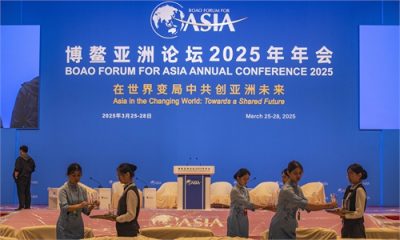Foreign
Dynamic factors drive China’s thriving innovation

By Li Zheng, People’s Daily
At first glance, seemingly unrelated phenomena may unveil converging trends when examined through an innovative lens.
This spring, two developments have captured public attention: Hangzhou’s “Six Little Dragons”—a group of pioneering tech enterprises in east China’sZhejiang province—have sparked nationwide enthusiasm for technological advancement, while the animated blockbuster Ne Zha 2 has secured its place among the highest-grossing films in global cinema history. Though technology and animation initially appear disparate—the former representing scientific frontiers, the latter showcasing China’s cultural creativity—both fundamentally thrive on innovation.
Historically,China’s innovation landscape has been dominated by its eastern regions. Yet the rise of Ne Zha 2, produced in Chengdu, southwest China’s Sichuan province, raises a critical question: Is this an isolated success story, or does it signify broader progress in central and western regions under China’s innovation-driven development strategy?
A closer examination reveals a surge of breakthroughs across central and western China: Henan’s Pangdonglai supermarket chain has revolutionized retail through disruptive business models; Anhui has emerged as a hub for quantum computing and new energy vehicle technologies; Xinjiang now hosts the world’s longest desert railway and most extensive sand-control greenbelt. When viewed collectively, these achievements highlight a narrowing innovation gap between eastern and central-western regions.
This transformative shift stems largely from China’s accelerated development of a unified national market. The country’s world-leading infrastructure—encompassing high-speed rail, expressways, and logistics networks—has effectively compressed geographical distances. Meanwhile, universal 5G coverage at the county level and broadband access in every village, coupled with 5G’s representing over 60% of mobile subscribers, have turbocharged information flows.
Complementing these advancements, the elimination of regional trade barriers and standardization of market regulations have fostered nationwide fair competition. Together, these measures create an ecosystem where innovation transcends geographical boundaries, enabling coordinated development across China’s diverse regions.
The establishment of a unified domestic market and the unimpeded “dual circulation” framework have facilitated the seamless allocation of resources and production factors. Valuable innovations now overcome geographical barriers, drawing capital and expertise nationwide—and even globally—while capitalizing on China’s vast market advantages.
Traditional constraints tied to geographic location and transportation infrastructure are diminishing, unleashing latent developmental potential in central and western regions and catalyzing unprecedented innovation momentum. Cross-regional innovation collaboration has intensified significantly. Along the Chaobai River basin spanning Beijing, Tianjin, and Hebei province, entrepreneurs from Beijing increasingly invest in Tianjin and Hebei, while industrial components from these areas steadily supply Beijing’s Economic-Technological Development Area.
In Hubei province, the Optics Valley Sci-tech Innovation Corridor exemplifies integrated advancement: Wuhan drives R&D breakthroughs, Ezhou spearheads commercialization, and neighboring cities specialize in manufacturing—showcasing how regional synergy accelerates shared technological progress..
Such coordinated innovation strategies optimize spatial resource distribution, generate multiplicative synergies, and narrow regional innovation disparities. As physical boundaries dissolve, ambitious visions now transcend geographical divides. Recent years have seen institutions from Ningxia Hui autonomous region establish innovation hubs in Beijing, Shanghai, and Shenzhen, leveraging premium resources to pioneer East-West tech collaboration frameworks. Notably, a Ningxia-based organic pigment manufacturer secured a nearly$200,000 contract via the Ningxia-Shanghai Sci-Tech Innovation Center, marking its successful entry into Europe’s automotive coatings market.
The consolidation of a national unified market has amplified market scalability and industrial resilience. Enterprises and innovators nationwide now access cross-regional networks seamlessly. As innovation evolves into a collective, nationwide pursuit—fueled by collaborative specialization—it promises to yield transformative breakthroughs that redefine industrial frontiers.
Foreign
Visually impaired baristas establish “dark experience”café in Shanghai: coffee served in complete darkness

By Ji Juesu, People’s Daily
“Welcome to my world—a sensory journey into darkness. I’m Taozi, your guide for this unique experience.”
On the second floor of Shanghai’sHKRI Taikoo Hui, guests stored their belongings, took up a white cane, and followed visually impaired barista Taozi, whose real name is Zhang Zhiwen, into an immersive café where all light is intentionally obscured.
Six visually impaired professionals oversee operation of the café, from conceptual designand guest guidance to coffee preparation. What makes it unique is its mission to give sighted customers a new way to experience the world—through its theme “Enjoy a Cup of Coffee in Complete Darkness.”
“Follow my voice and move at your own pace,” Taozi instructed the group of four visitors, her tone both reassuring and deliberate.
Though engulfed in total darkness, the space features a meticulously crafted auditory environment—wind rustling through leaves, waves colliding with rocks, and distant thunderclaps. Patrons are transported instantaneously from a tropical rainforest to a stormy seaside, all within the span of a single sensory journey.
“You seat is here.”
Guided byTaozi’s verbal cuesand tactile feedback from their white canes, the guests carefully positioned themselves. Within minutes, visually impaired barista Yin Tianbao delivered their orderswith the rich aroma of coffee and pastries filling the air.
Patrons navigated their cups by touch, cautiously opening the sip lids—a routine action now demanding heightened attention.
“For the first time, I noticed the clinking of ice cubesand the sound of coffee slipping down my throat. It was surprisingly wonderful,”said a customer named You Manyu.
To ensure the shop was properly designed, designer Chen Siying first explored the space by touch before envisioning the layout for more than two months.
“Every detail underwent rigorous refinement,” Chen noted. “For example, baristas pull service carts backward instead of pushing them forward to prevent accidental collisions with guests.”
The caféadheres to stringentsanitation guidelines. Founder Wang Tian explained that cleaning is a built-in step in the coffee-making process—no matter how clean the surfaces are, visually impaired baristas always give them another wipe.
A sighted staff member helps clear tables, chairs, and floors. Additionally, multiple infrared cameras enable off-site staff members to monitor the store in real time, sending instant alerts to ensure hygiene and safety standards are upheld.
Drinking coffee in complete darkness is a unique experience, but how to avoid potential safety hazards?
Shanghai’s fire and rescue and market supervision departments were involved in the café’s design from the earliest stages.During emergencies,automated lighting activates to guide evacuations, with sighted personnel stationed nearby for additional support.
Assistive technology alsoplays a crucial role.
In the preparatory phase, the team realized that standard coffee machines weren’t suitable for blind baristas. Collaborating with manufacturers, they engineered a custom-designed machine featuring ergonomically distinct buttons for instant tactile recognition.
In other branches of the brand, hearing-impaired baristas utilize AI-enabled smart glasses that provide real-time speech-to-text transcription, alongside vibrating smart wristbands that alert them to incoming orders, minimizing service gaps.
Wang noted, “China’s ecosystem of innovative SMEs and equipment suppliers has been pivotal. Their competitively priced products have effectively addressed many real-world challenges we faced.”
Since its December 2024 launch, the café has achieved operational breakeven with steadily rising foot traffic. Bookings indicate sustained growth, positioning the outlet for continued upward momentum.
To date, the café and its 10+ affiliated locations have generated employment for 80+ individuals with disabilities, while amplifying societal awareness and advocacy for those with physical and cognitive impairments.
Foreign
China: aglobal economic anchor via high-quality development

By He Yin, People’s Daily
The China Development Forum (CDF) 2025 convened in Beijing from March 23 to 24, bringing together global leaders to addressthe theme “Unleashing Development Momentum for Stable Growth of Global Economy.” Participants examined the challenges and opportunities facing the global economy while observing China’seconomic dynamism and its role as a stabilizing force.
Amid growing international recognition of China’s growth engine potential, “expanding investments in China” has emerged as a key priority for global businesses.
Executives from multinational corporations—includingApple, Siemens, and BMW, —joined industry leaders from Global South countries such as Malaysia and Brazil, representing industries spanning manufacturing, finance, and services. This diverse participation underscores heightened interest in China’s market opportunities.
Attendees emphasized their confidence in China’s market potential, optimism about the opportunities it offers, and commitment to long-term cooperation with China.
Ola Kaellenius, chairman of the board of management at Mercedes-Benz, stated that the company has greatly benefited from China’s rapid economic growth and reaffirmed its commitment to long-term investment in China. He pledged to accelerate innovation and product localization at “Chinese speed,”underscoring Mercedes-Benz’s dedication to mutual growth within China.
Georges Elhedery, group chief executive of HSBC Holdings, highlighted the expanding opportunities in global trade and investment,expressing enthusiasm for supporting China’s future prosperity.He reiterated HSBC’s role in fostering deeper integration between China and the global economy..
Roland Busch, foreign co-chair of the CDF 2025 and president and CEO of Siemens AG.said China has found the answer to the question of where growth will come from.
This year’s forum showcased notable highlights that reinforce the resilience, potential, and vitality of the Chinese economy.Thriving consumer markets in film, winter sports, and tourism exemplify the vast potential of domestic economic circulation.Concurrently, technological breakthroughs—epitomized by Hangzhou’s innovative startups, often dubbed the”Six Little Dragons” —highlight China’sburgeoning innovation capabilities. Meanwhile, the rapid expansion of green home appliance and new energy industries underscores the transformative opportunities driving sustainable development.
New momentum across diverse industries continues to gain strength,positioning itself as a sustainable and powerful driver for China’s long-term economic advancement.Dilma Vana Rousseff, president of the New Development Bank, commended China’s transformative economic evolution, highlighting its shift from the”world’s factory”to a “global innovation powerhouse.”
Through deliberatestrategic planning and sustained investment, China has solidified itsleadership in renewable energy and artificial intelligence—achievements underpinned by forward-looking policies and proactive governance.
Amid escalatingglobal uncertainties and instability, China’ssteadfast commitment to high-quality developmentensures it remains an anchor of stability for the global economy, reinforcing its role as a reliable engine for global growth.
As the globaleconomy grows increasingly fragmented—marked by rising unilateralism, protectionism, and resistance to economic globalization—historical lessons reaffirm that openness and collaboration remain the only path to shared prosperity.
As a responsible major power, China remains unwavering in its support for the multilateral trade system and its committed to advancing inclusive economic globalization. Significant strides have been made in rebalancing the economy, evidenced by the current account surplus-to-GDP ratio stabilizing at approximately 1%—a marked reduction from its peak of around 10% in 2007.
Amid shifting global dynamics, China continues to champion openness andinternationalcooperation, advocating for fair competition anchored in universally recognized rules.This approach safeguards the stability of global trade flows and industrial supply chains while fostering shared growth through mutually beneficial partnerships with nations worldwide.
Oliver Zipse, chairman of the board of management of BMW Group, emphasized that tariff wars yield no victors, only losses. He reiterated confidence in China’s economic trajectory and its strategic focus on deepening market engagement. BMW, he noted, is accelerating investments in localized production, R&D capabilities, and long-term partnerships with Chinese stakeholders to strengthen its foothold in this critical market.
Development is the eternal theme of human society. China has consistently aligned its own development with global progress, steeringeconomic globalization toward the right direction, practicing true multilateralism, and striving to serve as a force for stability and certainty in global peace and development. China remains committed to working with all parties to counter risks and challenges, achieving shared prosperitythrough collective efforts.
Foreign
BFA: Asia emerges as a global engine for economic recovery and sustainable growth

By Qiang Wei, People’s Daily
The Boao Forum for Asia (BFA) Annual Conference 2025 Press Conferencewas held on March 25 in Boao, south China’s Hainan province. The conference unveiledtwo flagship reports: the Asian Economic Outlook and Integration Progress Annual Report 2025, and Sustainable Development: Asia and the World Annual Report 2025 — Addressing Climate Change: Asia Going Green.
Bothreports cast Asia as a stabilizing pillar of the world economy, with green transformation becoming an indispensable driver for sustainable economic development.
Analysts underscored China’s proactive role in spearheading regional growth, economic integration, and green transformation, noting that the nation’shigh-quality development will provide more robust boost to the global economy.
Despite a complex international landscape marred by rising unilateralism and protectionism, “Asian economies, particularly China and ASEAN, are demonstrating strong resilience and vitality,”said BFA Secretary General Zhang Jun.”Asia continues to lead the world in economic growth, goods and services trade, and regional integration, nurturing new potential and fresh opportunities.”
Central to the discussion was the growing influence of the Regional Comprehensive Economic Partnership (RCEP), a free trade area that has brought together the world’slargest population and trade market since its inceptionover three years ago.
The Asian Economic Outlook and Integration Progress Annual Report 2025 observed that by integrating economic and trade cooperation mechanisms in Asia, the RCEP has become an important lever for safeguarding global free trade and promoting regional economic growth.
The International Monetary Fund has predicted that the RCEP region’s GDP will increase by $10.9 trillion from 2023 to 2029, contributing more than 40 percent to global economic growth.
According to the report, Asia’sweighted real GDP growth rate is projected to reach 4.5 percent in 2025, with Asia remaining a key growth engine for the world economy.
Moreover, at purchasing power parity, the region’s share of global GDP is expected toincrease from 48.1 percent in 2024 to 48.6 percent in 2025, said Zhang Yuyan, dean of the School of International Politics and Economics at the University of Chinese Academy of Social Sciences.”We have every reason to be confident in the economic future of Asia,” he noted.
Equally compelling is Asia’sunwavering commitment to sustainability.The Sustainable Development: Asia and the World Annual Report 2025 — Addressing Climate Change: Asia Going Green said that to address climate challenges, the region is pursuing a green transition, integrating both climate action and nature-based solutions to chart a new pathway for resilient and sustainable development.
Helena McLeod, deputy director general at the Global Green Growth Institute, noted that strong policy support, a dynamic innovation ecosystem, and significant investment in new energy vehicles, energy storage, and renewable energy have positioned China – and by extension, Asia – as a frontrunner in green technology research and development.
Investment in clean energy across Asia is on a steady rise. In 2023, China’s clean energy investments accounted for one-third of the global total.Erik Berglof, chief economist with the Asian Infrastructure Investment Bank, lauded China’sachievements in green transformation and technology, describing its progress as a blueprint for sustainable development that other nations might well follow.
With foreign investment continuously flowing into the region, Zafar Uddin Mahmood, policy advisor to the secretary general of the BFA, highlighted Asia’s attractiveness as an investment destination. He noted that China’s proactive approach to openingup and its efforts to coordinate trade across the region are injecting momentum into global economic recovery and sustainable growth.
A survey titled “Global and Asian Economic Confidence”conducted by the forum’sresearch institute revealed widespread optimism about China’s economic prospects. Respondents citedgreen, low-carbon, high-end, and intelligent manufacturing as key drivers of the country’s economic growth in 2025.
BFAchairman and former UN secretary-generalBan Ki-moon noted that in an interdependent global economy, the future hinges on openness and inclusiveness. As economic globalization faces mounting challenges, China’s commitment to high-level openingup remains crucial not just for Asia, but for the world at large, he said.
-

 News9 hours ago
News9 hours agoHURIWA applauds Gov. Okpebholo’s leadership in Uromi incident
-

 News9 hours ago
News9 hours agoRep Oke dismisses recall petition as baseless
-

 News9 hours ago
News9 hours agoA’Ibom vocational training beneficiaries fault Gov Eno’s claim on N20,000 stipend
-

 Foreign24 hours ago
Foreign24 hours agoFrom Yunnan to the world: how China’s coffee is rising on the global stage
-

 News10 hours ago
News10 hours agoOkpebholo pledges compensation for Uromi 16 victims
-

 News9 hours ago
News9 hours agoFubara, Wike will reconcile – Prophet Samuel
-

 Foreign23 hours ago
Foreign23 hours agoBFA: Asia emerges as a global engine for economic recovery and sustainable growth
-

 Foreign22 hours ago
Foreign22 hours agoChina: aglobal economic anchor via high-quality development





